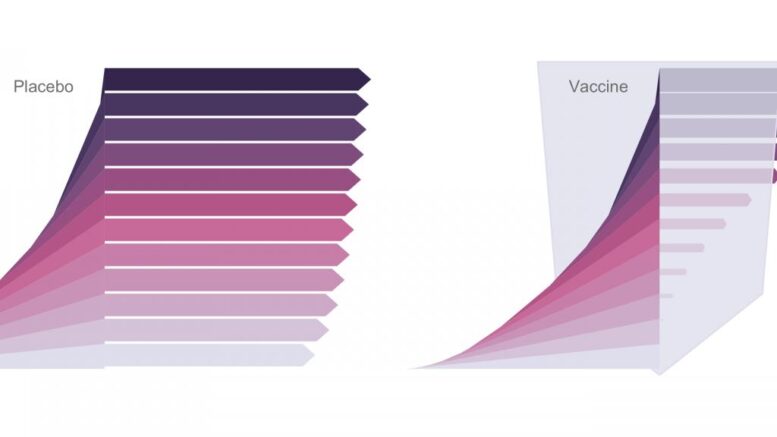Vaccines are based on a part of the virus, which grants specific immunity. This immunity is a kind of barrier to infection, represented by the shield here, but it may be an imperfect one. Viruses evolve, and accumulating changes (in darker shades of purple) may sufficiently modify the virus so that it is no longer recognized by the immune system, thereby metaphorically passing through the defenses created by the vaccine. By studying these "breakthrough" infections, and comparing them to the viruses that infected people given a placebo, researchers can identify the key viral changes that allowed the virus to breach the vaccine protection and lowered its efficacy. They can then adapt future iterations of the vaccine to help minimize this type of escape -- effectively shoring up the protective barrier. Courtesy of Bethany Dearlove/MHRP
As concern has grown over COVID-19 variants and their implications for how well COVID-19 vaccines will protect against the virus, researchers have proposed a method to examine instances of SARS-COV-2 infections in people who have received a COVID-19 vaccine.
Genomic sieve analysis of these so-called "breakthrough" SARS-CoV-2 infections in COVID vaccine trials is a critical tool to identify viral mutations associated with vaccine failure and to predict how vaccination impacts the virus' evolution.
Dr. Morgane Rolland, chief of viral genetics for the U.S. Military HIV Research Program at the Walter Reed Army Institute of Research, and Dr. Peter Gilbert, biostatistician and professor at the Vaccine and Infectious Disease and Public Health Sciences Divisions at Fred Hutchinson Cancer Research Center, described the strategy in a recent publication in PLOS Pathogens.
"No vaccine is 100 percent effective, so even in clinical trials for the highly effective COVID vaccines being rolled out now, some of the trial volunteers who received the vaccine experienced breakthrough infections," explained Rolland. "Sieve analysis compares those breakthrough viruses to those that infected the placebo group to help pinpoint which variants are evading the vaccine-induced immune response and inform efforts to improve COVID vaccines."
Gilbert added, "Think of the vaccine as a sieve and different variants as pebbles poured into the sieve: the vaccine will block some variants but allow others to pass through, and sieve analysis learns which variants make it through."
Sieve analysis allows scientists to recognize evolutionary patterns that will be key to infer how SARS-CoV-2 might adapt to widely used vaccines and predict how virus evolution could eventually impact vaccine efficacy. The paper's authors note SARS-CoV-2 is relatively slow to mutate, meaning it's unlikely current vaccines will be rendered obsolete soon, but increased vigilance is needed in the months until a majority of the population has been vaccinated to stem spread of concerning variants.
"The variants that emerged in the past two months highlight the need for next generation vaccines," said Rolland. "Conducting sieve analysis of samples obtained through vaccine trials is an efficient way to determine how future vaccines should be designed."
Source: U.S. Military HIV Research Program (MHRP)

Be the first to comment on "Research Technique Provides Insights on Potential Mechanisms of Vaccine Protection and on Risks for Future Vaccine Resistance"